Octopoteuthis
Richard E. Young and Michael Vecchione- Octopoteuthis danae
- Octopoteuthis deletron Young, 1972
- Octopoteuthis indica
- Octopoteuthis neilseni
- Octopoteuthis megaptera
- Octopoteuthis rugosa
- Octopoteuthis sicula
Introduction
Subadults and adults of Octopoteuthis lack tentacles. All the arms terminate in photophores and these photophores lack muscular lids. Instead, they possess mobile chromatophores that conceal the photogenetic tissue. Arm tips of Octopoteuthis are frequently broken off during capture. This "fragility" is probably a normal defensive weapon (see Behavior of O. neilseni).
The species in this genus are poorly defined and identification, therefore, may be difficult.
Brief diagnosis:
An octopoteuthid ...
- with elongate, small, dark photophores at tips of all arms.
Characteristics
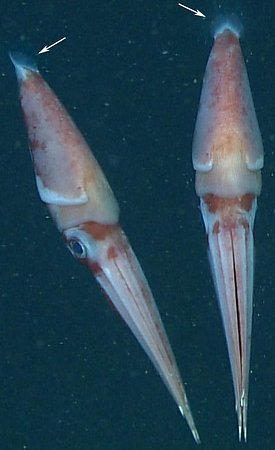
Figure. Dorsolateral and dorsal views of O. deletron showing the tail flaps (arrows). In situ photographs taken by an MBARI ROV at a depth of 645 m. Photographs © 2013 MBARI.
- Tentacles
- Tentacles absent in subadults.
- Head
- Beaks: Descriptions can be found here: O. neilseni lower beak, upper beak from Hawaiian waters. Octopoteuthis sp. A and Octopoteuthis danae lower beaks, upper beaks from North Atlantic waters.
- Beaks: Descriptions can be found here: O. neilseni lower beak, upper beak from Hawaiian waters. Octopoteuthis sp. A and Octopoteuthis danae lower beaks, upper beaks from North Atlantic waters.
- Mantle
- Peculiar tail flaps seen in O. deletron and presumably present in all Octopoteuthis spp. Function of flaps unknown. See photographs at left.
- Peculiar tail flaps seen in O. deletron and presumably present in all Octopoteuthis spp. Function of flaps unknown. See photographs at left.
- Photophores
- Slender, dark photophores at tips of all arms.
- One or two large tail photophores.
Comments
Species of Octopoteuthis have a variety of photophores in addition to those listed above as being characteristic for the genus. This diagram names the organs that are most easily found in dissection. The variation between species in photophore arrangement is poorly known. The most obvious difference is the presence of one or two tail organs.
Nomenclature
Pfeffer (1912), with reservations, described the genus Octopodoteuthopsis based on Verrill's Ancistrocheirus megaptera primarily due to the more widely spaced hooks in this species compared to Octopoteuthis sicula. Adam (1952) suggested that this and Octopoteuthis were synonymous but Voss (1956) maintained their distinctness. The two were treated as synonyms by Young (1972).
The type species of the genus, Octopoteuthis sicula, has been known as Octopodoteuthis sicula for many years due to an illegal emendation of the original spelling. Octopoteuthis persica Naef, 1923 was transferred to Taningia by Young (1972). Chun (1910) described a 3.8 mm paralarva from the Indian Ocean (34° 31'S, 26° 00'E) which Naef (1923) found to be different from the paralarvae he examined of O. sicula from the Mediterranean Sea. He named Chun's paralarva, O. indica but no subsequent work has clarified the use of this name. O. longiptera Akimushkin, 1963, from the South Atlantic, was described from a whale stomach, and considered a species dubia by Young (1972).
Species
According to Young (1972) the systematics within this genus rests primarily on three features: (1) the number of tail photophores; (2) the size of the tail in small specimens; (3) the presence of accessory cusps on the hooks in small specimens.
In the North Pacific two species are known: O. deletron with a single tail photophore and O. neilseni with two tail photophores.

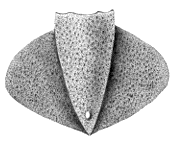
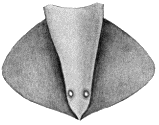
Figure. Ventral view of the mantle and fins of Octopoteuthis showing the two North Pacific species with virtually no tails but differing patterns of tail photophores: Left - O. deletron. Right - O. neilseni. Drawings from Young (1972).
In the North Atlantic, three forms are known: One, O. sp. A with a single tail photophore, absence of accessory cusps on the arm hooks and a long tail, and two forms with two tail photophores. One of the latter, O. danae, has a tail of moderate length while the other, O. megaptera, (right drawing) has a long tail. The type species of the genus, the Mediterranean species O. sicula, appears to be the senior synonym of O. danae and very closely related or possibly conspecific with O. megaptera (Jereb, et al., 2016). Also the later authors concluded that only a single species, O. sicula, exists in the Mediterranean Sea.

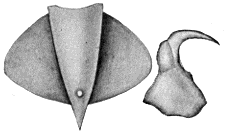
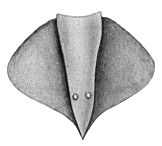
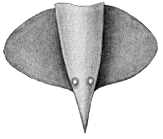
Figure. Mostly ventral views of mantles and fins of Atlantic species of Octopoteuthis. Left - Octopoteuthis sp. A, 49 mm ML with a lateral view of a large arm hook from the same specimen. Center - O. danae (= O. sicula ?), 53 mm ML. Right - O. megaptera, 38 mm ML. Drawings from Young (1972).
Clarke (1980) described O. rugosa from the waters off South Africa and south Australia, from very large specimens (14.5-23 cm ML) and is based primarily on rugose texture of the mantle. This feature has been found to be a characteristic of mature or maturing females (Hoving et al., 2011) and is probably of little value a specific character, making this a dubious species.
Nesis (1982/87) indicates that the presence of arm base photophores on arms III and IV is a specific character that is absent in O. megaptera and O. danae (= O. sicula ?). These photophores, which can be difficult to see, however, were found in at least some Mediterranean O. sicula (Jereb et al., 2016), which suggests that this is a possible character distinguishing O. sicula and O. megaptera).
Behavior
On several occasions, while observing O. neilseni aboard ship, a bright bioluminescent flash was observed from the caudal area, that presumably came from one or both of the tail photophores.
On one occasion we cut an arm off a moribund O. neilseni that was being observed in seawater in a pan. The portion of the arm that was separated from the squid immediately began to wiggle violently while the arm tip photophore flashed brilliantly. On another occasion an arm tip was found in the bottom of a shipboard tank that held a living O. neilseni. Squid of Octopoteuthis qenerally are retrieved from the trawl without several arm tips of differing length, and often squid are captured with one or more arm tips in the process of regeneration. This evidence suggests that the arm tips can either be autotomized or are easily broken by an attacking predator and that the detached, flashing and wiggling arm tip acts as a lure to detract the predator the squid attempts to escape, similar to the function served by the autotomized tail of a terrestrial lizard.


Figure. Ventrolateral view of the brachial crown of O. megaptera photographed swimming in shipboard aquarium. Several of the arms have recently lost tips. Two arms (boxed) and probably three (right arm IV) have regenerating tips. Note that the arm stubs are of very different lengths. Inserts show enlargements of boxed areas. Illustration modified from a photograph taken by .
O. neilseni has been observed to counterilluminate in shipboard aquaria.
Life History
The paralarva is very distinct. Broad but delicate mantle and head; weak tentacles with short clubs bearing a few very large suckers and a few small suckers.
References
Clarke, M. R. 1980. Cephalopoda in the diet of sperm whales of the Southern Hemisphere and their bearing on sperm whale biology. Discovery Reports, 37: 1-324.
Hoving, H., S. Bush and B. Robison. 2011. A shot in the dark: same-sex sexual behaviour in a deep-sea squid. Biol. Lett. Marine Biology. doi:10.1098/rsbl.2011.0680.
Jereb, P.,and 20 co-authors. 2016. The deep‑water squid Octopoteuthis sicula Rüppell, 1844 (Cephalopoda: Octopoteuthidae) as the single species of the genus
occurring in the Mediterranean Sea. Mar Biol (2016) 163:192
DOI 10.1007/s00227-016-2965-0
Young, R. E. 1972. The systematics and areal distribution of pelagic cephalopods from the seas off Southern California. Smithson. Contr. Zool., 97: 1-159.
Title Illustrations

| Scientific Name | Octopoteuthis deletron |
|---|---|
| Location | off Hawaii |
| Specimen Condition | Live Specimen |
| Life Cycle Stage | subadult |
| View | lateral |
| Image Use |
 This media file is licensed under the Creative Commons Attribution-NonCommercial License - Version 3.0. This media file is licensed under the Creative Commons Attribution-NonCommercial License - Version 3.0.
|
| Copyright |
© 1996

|
About This Page

University of Hawaii, Honolulu, HI, USA

National Museum of Natural History, Washington, D. C. , USA
Page copyright © 2016
 Page: Tree of Life
Octopoteuthis .
Authored by
Richard E. Young and Michael Vecchione.
The TEXT of this page is licensed under the
Creative Commons Attribution-NonCommercial License - Version 3.0. Note that images and other media
featured on this page are each governed by their own license, and they may or may not be available
for reuse. Click on an image or a media link to access the media data window, which provides the
relevant licensing information. For the general terms and conditions of ToL material reuse and
redistribution, please see the Tree of Life Copyright
Policies.
Page: Tree of Life
Octopoteuthis .
Authored by
Richard E. Young and Michael Vecchione.
The TEXT of this page is licensed under the
Creative Commons Attribution-NonCommercial License - Version 3.0. Note that images and other media
featured on this page are each governed by their own license, and they may or may not be available
for reuse. Click on an image or a media link to access the media data window, which provides the
relevant licensing information. For the general terms and conditions of ToL material reuse and
redistribution, please see the Tree of Life Copyright
Policies.
- Content changed 16 November 2016
Citing this page:
Young, Richard E. and Michael Vecchione. 2016. Octopoteuthis . Version 16 November 2016. http://tolweb.org/Octopoteuthis/19839/2016.11.16 in The Tree of Life Web Project, http://tolweb.org/







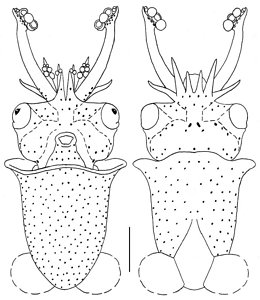



 Go to quick links
Go to quick search
Go to navigation for this section of the ToL site
Go to detailed links for the ToL site
Go to quick links
Go to quick search
Go to navigation for this section of the ToL site
Go to detailed links for the ToL site